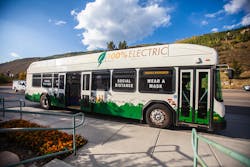Black & Veatch upgrading electric system to pave way for bus EVs in ski destination community
By Rod Walton, EnergyTech Senior Editor
Black & Veatch will upgrade the electrical systems in Vail, Colorado as the town prepares to transition to electric buses.
The town’s ski mountains face a threat from climate change and the electrification of its bus fleet will help reduce emissions. Black & Veatch will provide the consulting and pre-construction services for the transition.
GILLIG will provide the buses and ChargePoint will be responsible for installing charging stations.
The first phase of this transition began in 2020 and the firms have already deployed four electric buses. The electrification is expected to complete by 2032.
“We chose to work with Black & Veatch on this project due to their experience and reputation of success in the field of electric vehicle charging,” said Greg Hall, director of public works and transportation for the Town of Vail. “In our work with them, their expertise and passion for sustainability really shone through, bringing added value and success to the project.”
See EnergyTech's full coverage of E-Mobility projects
Black & Veatch’s services include upgrades to the electrical system, a microgrid feasibility study, technology consulting, site survey, utility coordination, and environmental compliance as well as design services for charging station installation.
“As a company with a stated mission for decarbonization, Black & Veatch values working on projects that push our nation closer to net-zero carbon,” said Maryline Daviaud Lewett, director of business development at Black & Veatch. “Of course, we want to see electrification of transportation in all cities, but in a town like Vail with such delicate, pristine outdoor destinations and landscape, it feels especially right to be building clean, sustainable infrastructure.”
Black & Veatch also completed the high-power electric charging station infrastructure that powers Washington, D.C.’s Circulator System, the capital’s new electrified mass transit project that eliminates nearly 244,000 pounds of carbon dioxide emissions annually.
Vail aims to reduce greenhouse gas emissions by 25% in 2025, 50% in 2030 and 80% by 2050. The town has less than 10,000 permanent residents but gains nearly one million tourist visitors annually.
(Rod Walton is senior editor for EnergyTech, a website devoted to coverage of how industries and companies take the energy transition, from microgrids to EV infrastructure, CHP and energy efficiency. Walton is a 14-year veteran as an energy journalist, including newspapers and business media. He can be reached at [email protected] or by calling 412-376-7454).
